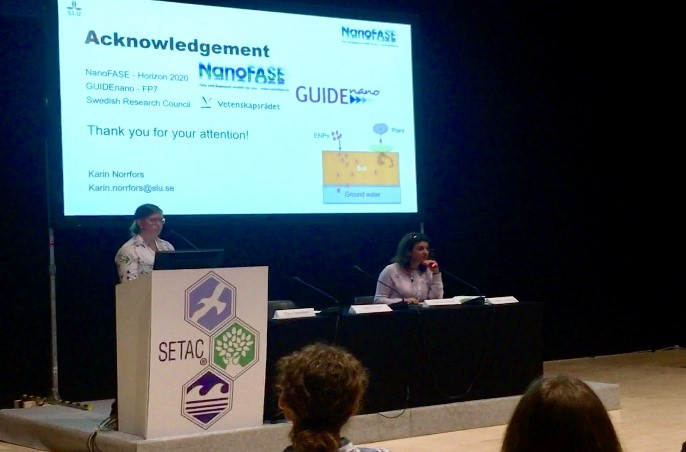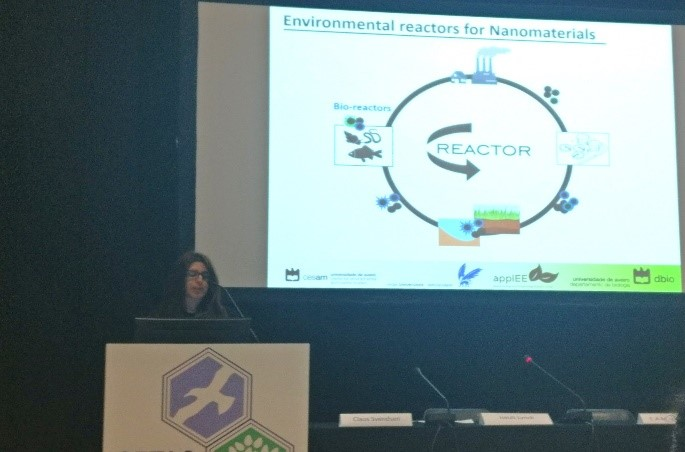NanoFASE participation in SETAC Rome
NanoFASE took the road to Rome for the 28th annual meeting of SETAC Europe, presenting papers and posters, chairing sessions and offering a workshop.
For Claus Svendsen, NanoFASE project coordinator, "The SETAC conference is one of the most important opportunities in the year to talk with our peers and end users whose work could be impacted by NanoFASE fate and exposure models. It was really encouraging to see the positive and engaged reactions to our partners – particularly our Young Scientists – presenting their NanoFASE work. We were proud to chair the SETAC Nanotechnology Interest Group meeting that provided plenty of feedback on directions taken in the field."
"I’m especially thankful to our many stakeholders who gave us their time at the NanoFASE hands-on consultation event, from which we got really useful guidance" for the continuing development of our clickable Exposure Assessment Framework. This already rich online resource will be significantly extended and remodelled by autumn 2018, and a webinar organized to obtain industry stakeholder views.
Register here.
‘The Environment as a Reactor Determining Fate and Toxicity of Nanomaterials’ was a double platform session chaired by NanoFASE partners. The open call gathered a dozen high-quality presentations (read abstracts online at SETAC: part I and part II) including six from NanoFASE:
- Nathaniel Clark et al. (UoP) "Development of a rapid screen to assess bioaccumulation potential: from ex vivo to in vivo using pristine and aged nanomaterials in fish"
- Patricia Silva et al. (UAVR) "Uptake and elimination kinetics of pristine and aged silver nanoparticles in freshwater benthic organisms"
- Helen Walch et al. (UNIVIE) "Tackling nanoparticle fate assessment in surface waters - heteroaggregation as a key process"
- Marta Baccaro et al. (WU) "Mobilisation of silver sulphide nanoparticles in soil column by earthworms´ bioturbation"
- Karin Norrfors et al. (SLU) "Determination of attachment efficiency for ENPs in different types of soils by saturated column experiments"
- Jonas Wielinski et al. (EAWAG) "The transformation of copper and zinc (-nanoparticles) during sewage sludge combustion"
With, in addition, five poster presentations:
- C. "Kees" van Gestel et al (VU-VMC) "Influence of soil type on the toxicokinetics of Ag and Ag2S nanoparticles and ionic Ag in soil invertebrates"
- Anita Jemec Kokalj et al. (Uni-Lj) "Terrestrial isopods as models to assess the biotransformation of nanoparticles inside the organisms: an example with silver and gold nanoparticles"
- Carolin Schultz et al. (NERC) "Assessment of the differential effects of transformation on the toxicity of nanomaterials with different size and coating properties to soil bacteria and the nematode Caenorhabditis elegans"
- Amaia Green-Extabe et al. (NERC) "The uptake of pristine and aged silver nanoparticles by wheat, Triticum aestivum, in a soil exposure"
- Alex Gogos et al. (EAWAG) "Influence of organic compounds on the sulfidation kinetics of copper oxide nanoparticles".

 NanoFASE Scientist Susana Loureiro (UoA) chaired the SETAC Rome session "The Environment as a Reactor Determining Fate and Toxicity of Nanomaterials" with Iseult Lynch (UoB), Cornelis A.M van Gestel (Vu) and Claus Svendsen (NERC). Here, Karin Norrfors (SLU) spoke on "Determination of attachment efficiency for ENPs in different types of soils by saturated column experiments" and Patrícia Silva (UoA) on "Uptake and elimination kinetics of pristine and aged silver nanoparticles in freshwater benthic organisms".
NanoFASE Scientist Susana Loureiro (UoA) chaired the SETAC Rome session "The Environment as a Reactor Determining Fate and Toxicity of Nanomaterials" with Iseult Lynch (UoB), Cornelis A.M van Gestel (Vu) and Claus Svendsen (NERC). Here, Karin Norrfors (SLU) spoke on "Determination of attachment efficiency for ENPs in different types of soils by saturated column experiments" and Patrícia Silva (UoA) on "Uptake and elimination kinetics of pristine and aged silver nanoparticles in freshwater benthic organisms".
|
The SETAC (Society of Environmental Toxicology and Chemistry) Europe 5-day Rome event featured training, networking and learning opportunities. Attended by approximately 2,500 scientists, risk assessors, regulators and managers from academia, business and government representing 60 countries, SETAC Europe meetings open doors to collaboration on emerging research and give insight on the latest methodologies as well as regulatory developments. |
